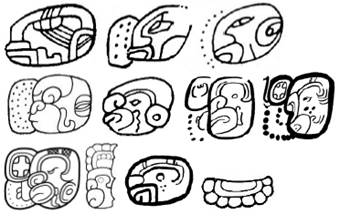![]()
![]()
![]()
![]()
![]()
K&H.p84.#8 TOK.p36.r4.c3 BMM9.p14.r7.c1 JM.p154.#5 MC.p164.r5.c1.4
K’UH K’UH K’UH K’U K’UH
![]()
JM.p155.#1
K’U
![]()
![]()
![]()
![]()

K&H.p84.#9 TOK.p9.r1.c2 TOK.p9.r1.c3 TOK.p9.r1.c4 MC.p164.r5.c1.2&3
= BMM9.p10.r5.c1 = BMM9.p10.r5.c2 = BMM9.p10.r5.c3
K‘UH K‘UH K‘UH K’UH K’UH
![]()
![]()
TOK.p9.r1.c1 MC.p164.r5.c1.1
K’UH

K&L.p32.#2
![]()
![]()
Mathews Coll-1 (Graham?)
LTI Panel 2 D1 YAX Lintel 46 I1
K’UH{ul}.<u:KAN> K’UH{ul}.<AJAW:wa>
· Schellhas and very early epigraphers called this “God C”, now also known to be more generally just the word for “a god”.
· Jackson&Stuart-AKT.p218.c2.l+13: “[T]he glyph […] depicting the portrait head of an important supernatural entity [was] designated “God C” nearly a century ago by Paul Schellhas (1904). This is a monkey-like face in profile, usually with a semicircle of dots or points attached to its front or left side […]. God C remains a somewhat enigmatic entity in the religious art of the Classic Maya, but there is general agreement that it serves in some way “to embody the ancient Maya concept of godliness” (Taube 1992:31)”.
· Jackson&Stuart-AKT.p219.l+9: “It should be noted that in some recent studies, the God C sign is transcribed as CH’UH, this being the Ch’olan and Greater Tzeltalan descendant of Common Mayan *k’uh (god) and the allomorph of Yukatecan k’uh”.
· Variants (3) – features:
o A. Simplest: a U-shaped arc of dots, representing droplets of divine energy or force.
o B. Medium: Equal to the simplest variant, but then L-shaped rather than U-shaped, plus a precious object (see below).
o C. Most complex: Equal to the medium variant, plus an anthropomorphic head (somewhat resembling a monkey?), consisting of:
§ Thick lips on the bottom left.
§ A nose just above the lips.
§ A partitive disk in the bottom right.
§ An eye in the middle.
§ An inverted-U as eye protector, running from the top of the nose, across the top, to the top of the partitive disk.
§ (Often) two double lines (~ pillars, though they can slant slightly outwards from bottom to top) from the eye protector to the ceiling of the head; (often) cross-hatched.
· Aside from the 3 main variants, other combinations can also occur (these can be seen in the examples from K&L, which are not separated out by variant), e.g.:
o Only the anthropomorphic head.
o The anthropomorphic head plus droplets but no precious object.
· While the most common order is precious object above and droplets below, this order is sometimes reversed, or the two are not stacked vertically, but instead joined horizontally (for example, when stacked above the anthropomorphic head).
· TOK.p9.r1.c2-4 indicate that the element (if present) above the blood drops is one of: K’AN, YAX, or spondylus shell; also explained in AT-E1168-lecture23.t0:02:00. They are the most common forms, but a number of others seem to occur as well: IK’ = “breath”, “wind” (LTI Panel 2 D1); upside-down la-face (MC.p164.r5.c1.4), even what appears to be one of the variants of jo (MC.p164.r5.c1.2). AT (=diagonally crossed bands) is not one of these precious objects – when present (for example in an EG), it is part of the “Polity Main Sign” (PMS), not part of K’UH{ul}.
· When the “precious object” is present:
o K’AN is most common form.
o YAX is less common, known from (for example) YAX Lintel 2 O4, YAX Lintel 16 F5.
o Spondylus shell is the least common.
o Other / not conforming:
§ LTI Panel 2 D1.
§ YAX Lintel 46 I1.
· The printed edition of JM reads this as K’U, without the -H. Surprisingly, this hasn’t been updated to K’UH in the online version (edited by Christophe Helmke). For the sake of uniformity, I have silently upgraded these transcriptions.
· There is a huge number of variants of k’uh and k’uhuL. A separate spreadsheet for EG’s exists to record them, including the features present or absent in the k’uhul-part.
· AT-E1168-lecture23.t0:01:51 explains that the anthropomorphic head is actually an animated celt, and that the K’AN, YAX, and spondylus shell represent precious objects (K’AN being a shell, and YAX being a bead, and the spondylus shell itself was a precious object used in Classic Maya art). These precious objects are then accompanied by a bunch of droplets.
![]()
![]()
JM.p155.#3 JM.p155.#4
k’u:hu k’u:hu
· The hu in both cases of JM is the rotated iguana head.